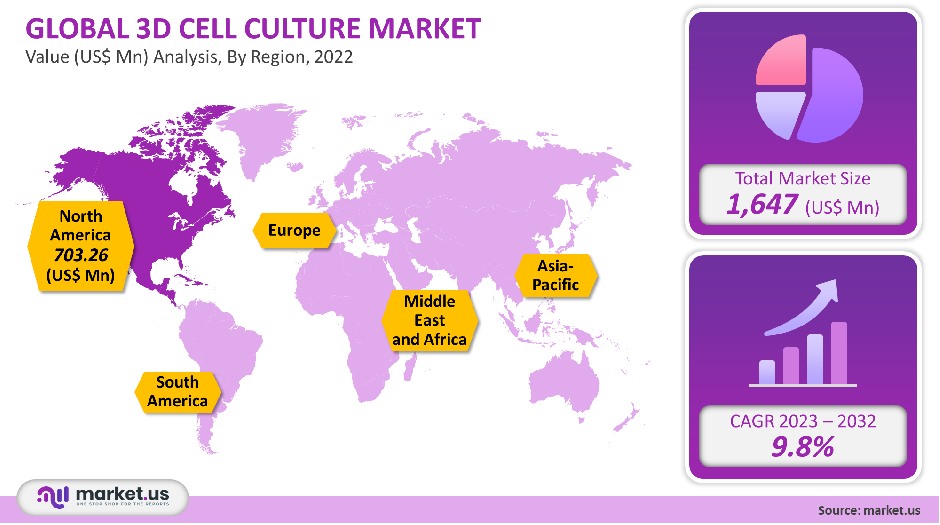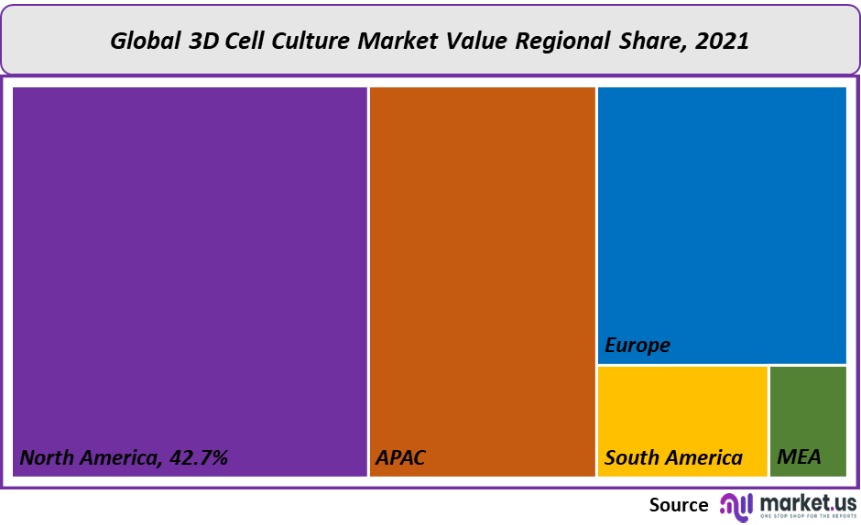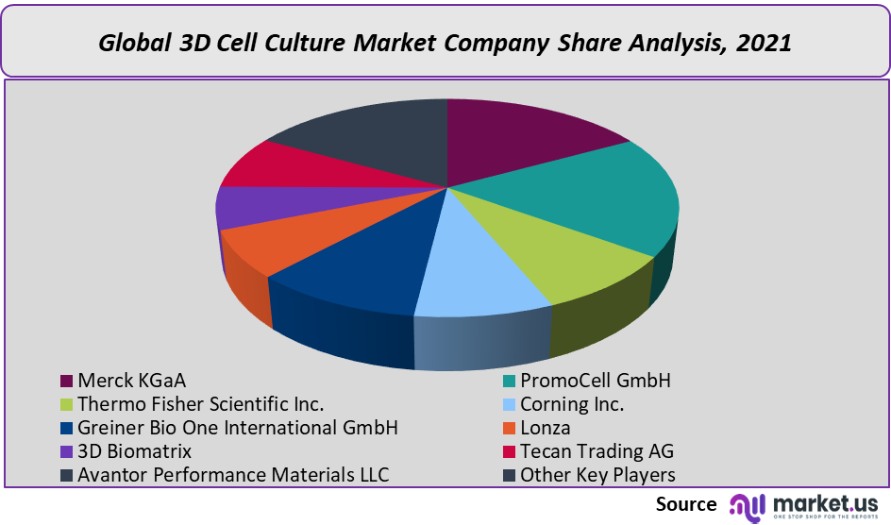Global 3D Cell Culture Market By Technology (Scaffold-based, Scaffold-free, and Bioreactors), By Application (Stem Cell Research, Cancer, and Others), By End-use (Biotechnology and Pharmaceutical Industries, Hospitals and Diagnostic Centers, and Others), By Region and Companies - Industry Segment Outlook, Market Assessment, Competition Scenario, Trends and Forecast 2022-2032
- Published date: Nov 2021
- Report ID: 21329
- Number of Pages: 211
- Format:
- keyboard_arrow_up
3D Cell Culture Market Overview:
The global market for 3D cell culture was worth USD 1,647 million in 2021. This market is expected to grow at a 9.8% CAGR.
They are used extensively in studies that require in-vivo model systems for analyzing the effects of foreign drugs on organs and tissues. A large number of researchers have adopted 3-dimensional cell culture techniques because biomimetic tissue constructions were able to create 3D organotypic structures.
The use of 3D tissue-engineered models for Covid-19 and cancer has been a viable alternative to traditional techniques. This method is also more cost-effective than 2D methods and can provide an in vitro tumor-host environment that is simple and affordable.
Global 3D Cell Culture Market
Technology Analysis
The largest share of revenue was attributed to scaffold-based technology, which was more than 67.2% in 2021. In 3-dimensional cell culture-based research, hydrogels can be used as scaffolds to allow for the incorporation of biochemical and mechanical signs that mirror the extracellular matrix. The market will grow due to the launch of new products, and the growing need for hydrogels to provide strong platforms for studying human physiology and cellular biology.
Highly stretchy hydrogels can now be 3D printed thanks to a technique developed by researchers at China’s Southern University of Science and Technology. This helps overcome the limitations associated with the performance and functionality of hydrogel-polymer-based scaffolds. Adocia, an Adocia-based biopharmaceutical firm, developed a hydrogel structure that could be used in cell therapy for Type 1 Diabetes.
Sales of scaffold-based technologies are predicted to rise as nanotechnology usage increases in biomedical research. Developing 3D tissue structures using magnetic levitation is a new, scaffold-free, and quickly expanding technique for tissue engineering. The segment without scaffolds will see the highest CAGR during the forecast period as a result of this.

Application Analysis
The market’s largest segment, cancer, had 23.86% of the total revenue in 2021. R&D in this sector is driven by the use of spheroids to develop anticancer therapies. The use of 3-dimensional cellular models to study cancer biology for preclinical testing and screening will also increase the segment’s revenue.
Research published in January 2021 reported the creation of polysaccharide-based hydrogel-based 3D printed tumor models. This can be used for high-throughput screening of anticancer drugs. Researchers sought to create hydrogel that could imitate the tumor microenvironment while also exhibiting appropriate biocompatibility and rheological characteristics. This research has led to a rise in scaffold-based treatments for cancer.
The segment stem cell research will experience the fastest CAGR between 2023 and 2032. The segment growth is expected to be driven by a rise in the use of 3D cell cultivation platforms for regeneration medicine.
Histogen Inc., which is a company involved in the development and commercialization of regenerative medicines, merged with Conatus Pharmaceuticals Inc., in January 2020. The latter has a solid pipeline of unique clinical candidates, including an extracellular matrix framework that is targeted at the treatment of conditions relating to articular cartilage.
End Use Analysis
The largest revenue share was earned by the pharmaceutical and biotechnology industries, which accounted for more than 45.8% of all revenues in 2021. 3D cell culture has advantages in terms of optimal oxygen and nutrient levels, non-uniform drug exposure, realistic cell-to-cell interactions, and realistic cell-to-cell interactions. This is in contrast to 2D cell cultivation to study potential drug candidates. These factors make 3D cell culture more useful for drug discovery, development, and testing.
The hospitals and diagnostic centers segment is growing due to factors like the urgent need for better diagnostic services and 3D models that provide detailed physiological information. In the future, it is expected that the segment will grow because of the existence of 3D modeling centers such as Kiyatec, which are active in advanced research.
The market is expected to grow in size due to both academic institutions and industrial laboratories. Over the forecast period, institutes will offer workshops and training programs in the 3D cell cultivation systems. This is expected to increase the demand for 3D-cell culture products & solutions.
Key Market Segments
Technology
- Scaffold-based
- Hydrogels
- Micro-patterned Surface Microplates
- Polymeric Scaffolds
- Nanofiber-based Scaffolds
- Scaffold-freeSpheroid Microplates with ULA coating
- Microfluidic 3D Cell Culture
- Hanging Drop Microplates
- Magnetic Levitation & 3D Bioprinting
- Bioreactors
Application
- Stem Cell Research
- Cancer
- Drug Development
- Tissue Engineering & Immunohistochemistry
- Others
End-use
- Biotechnology and Pharmaceutical Industries
- Hospitals and Diagnostic Centers
- Research Laboratories and Institutes
- Others
Market Dynamics
There are significant market growth opportunities due to the utility of 3-dimensional models to study Covid-19 and other respiratory disorders. The use of airway and air-liquid interface organoids has been instrumental in the discovery and development of antiviral medications. It also serves as an experimental virology platform to study the immune response and infectivity of SARS-2. Both scaffold-based and scaffold-less techniques allow for the bio-fabrication of realistic models that can be used in the development of new therapeutics or vaccines against Covid-19.
The market growth is also driven by the introduction of new products and the widespread use of 3D protocols for biological research. Envio Inc., a Canada-based biotechnology company launched EBPlate, a fully reusable microplate for 3D culture. This is expected to reduce wastage of single-use polymers, increase the utility of 3-dimensional microplates and accelerate zero-waste movement within laboratories.
Likewise, standard 2D analysis techniques can be easily applied to RAFT 3D cells manufactured by Lonza. Many laboratories worldwide have adopted these new technologies because they do not require significant changes to 2D culture techniques. Lonza also has 3D cell culture models that can be used to study drug-induced liver injury, hepatic signaling pathways, and in vitro Hepatotoxicity testing.
Regional Analysis
North America was the largest market globally in 2021 with a revenue share of 42.7%. This region will maintain its leadership position over the forecast period due to the available funding from both private and government sources for advanced 3D cell culture models, high healthcare spending, as well as the presence of many universities and research institutions that are investigating stem cell-based methods. Researchers at the Terasaki Institute (USA) and Mayo Clinic developed visible hydrogels in December 2020 that can be used to monitor and control hemorrhage.
The U.S. Department of Health and Human Services has launched “2020: A New Vision”, which recognizes regenerative medicine as an important part of healthcare. In terms of technological innovation and translational progress, the transformative effect of regenerative medicine in clinical stages is vital. However, Asia Pacific is expected to be the fastest growing regional market in 2023-2032 due to the increasing investment by several international companies in these emerging economies.

Key Regions and Countries covered іn thе rероrt:
- North America
- US
- Canada
- Mexico
- Europe
- Germany
- UK
- France
- Italy
- Russia
- Spain
- Rest of Europe
- APAC
- China
- Japan
- South Korea
- India
- Rest of Asia-Pacific
- South America
- Brazil
- Argentina
- Rest of South America
- MEA
- GCC
- South Africa
- Israel
- Rest of MEA
Market Sharing Analysis
To expand their market presence, market leaders are focusing on product launches and collaborations. Corning Inc., launched the Corning XSERIES, a cell processing platform that allows for cell and gene therapy applications in June 2020. This platform enables sterile, quick, efficient, automated processing. ThermoGenesis Holdings Inc. has manufactured the product. Corning Matrigel matrix-3D plate was also launched by ThermoGenesis Holdings Inc. This product is a more efficient and consistent option for cell culture that supports organoid or spheroid models.

Key Market Players
These are some of the most prominent players in 3D cell culture markets worldwide:
- Merck KGaA
- PromoCell GmbH
- Thermo Fisher Scientific Inc.
- Corning Inc.
- Greiner Bio One International GmbH
- Lonza
- 3D Biomatrix
- Tecan Trading AG
- Avantor Performance Materials LLC
- Other Key Players
Frequently Asked Questions (FAQ)
Q: What is the size of the 3D Cell Culture market in 2021?A: The 3D Cell Culture market size was US$ 1,647 million in 2021.
Q: What is the projected CAGR at which the 3D Cell Culture market is expected to grow at?A: The 3D Cell Culture market is expected to grow at a CAGR of 9.8% (2023-2032).
Q: List the segments encompassed in this report on the 3D Cell Culture market?A: Market.US has segmented the 3D Cell Culture market by geographic (North America, Europe, APAC, South America, and Middle East and Africa). By Technology, market has been segmented into Scaffold-based, Scaffold-free, and Bioreactors. By Application, the market has been further divided into Stem Cell Research, Cancer, Drug Development, Tissue Engineering & Immunohistochemistry, and Others. By End-use, market has been segmented into Biotechnology and Pharmaceutical Industries, Hospitals and Diagnostic Centers, Research Laboratories and Institutes, and Others.
Q: List the key industry players of the 3D Cell Culture market?A: Merck KGaA, PromoCell GmbH, Thermo Fisher Scientific Inc., Corning Inc., Greiner Bio One International GmbH, Lonza, 3D Biomatrix, Tecan Trading AG, Avantor Performance Materials LLC, and Other Key Players engaged in the 3D Cell Culture market.
Q: Which region is more appealing for vendors employed in the 3D Cell Culture market?A: North America is accounted for the highest revenue share of 42.7%. Therefore, the 3D Cell Culture industry in North America is expected to garner significant business opportunities over the forecast period.
Q: Name the key areas of business for 3D Cell Culture?A: The U.S., Canada, Germany, U.K., Japan, China, Brazil, South Africa are key areas of operation for 3D Cell Culture Market.
Q: Which segment accounts for the greatest market share in the 3D Cell Culture industry?A: With respect to the 3D Cell Culture industry, vendors can expect to leverage greater prospective business opportunities through the scaffold-based technology segment, as this area of interest accounts for the largest market share.
![3D Cell Culture Market 3D Cell Culture Market]()
- Scaffold-based
- Merck KGaA Company Profile
- PromoCell GmbH
- Thermo Fisher Scientific Company Profile
- Corning Inc.
- Greiner Bio One International GmbH
- Lonza Group AG Company Profile
- 3D Biomatrix
- Tecan Trading AG
- Avantor Performance Materials LLC
- Other Key Players
- settingsSettings
Our Clients
|
Single User
$5,999
$2,999
USD / per unit
save 50% |
Multi User
$7,999
$3,499
USD / per unit
save 55% |
Corporate User
$12,999
$4,499
USD / per unit
save 65% | |
|---|---|---|---|
| e-Access | |||
| Data Set (Excel) | |||
| Company Profile Library Access | |||
| Interactive Dashboard | |||
| Free Custumization | No | up to 10 hrs work | up to 30 hrs work |
| Accessibility | 1 User | 2-5 User | Unlimited |
| Analyst Support | up to 20 hrs | up to 40 hrs | up to 50 hrs |
| Benefit | Up to 20% off on next purchase | Up to 25% off on next purchase | Up to 30% off on next purchase |
| Buy Now ($ 2,999) | Buy Now ($ 3,499) | Buy Now ($ 4,499) |









